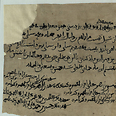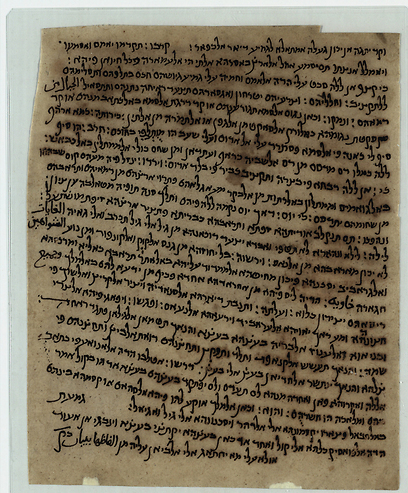
Afghan papers shed light on Jewish life
National library in Jerusalem unveils cache of 1,000-year-old documents written by Jewish community, which were discovered by chance in cave which have served as hideouts for Taliban insurgents
"This is the first time we have a large collection of documents representing the culture of the Jews who lived there" at the beginning of the 11th century, said academic director of the National Library of Israel, Professor Haggai Ben-Shammai.
Video courtesy of jn1.tv
The collection was discovered by chance in a cave inhabited by foxes some two years ago in northern Afghanistan, once at the outer reaches of the Persian empire. In recent years, the same caves have served as hideouts for Taliban insurgents in Afghanistan.
The Afghan "Geniza," the Hebrew term for ritual Jewish disposal of documents with religious significance which cannot be thrown out but must be buried, contains hundreds of papers currently held by collectors and dealers around the world.
It remains unclear how the ancient manuscripts emerged. Ben-Shammai said the library was contacted by various antiquities dealers who got their hands on them.
The collection gives an unprecedented look into the lives of Jews in ancient Persia in the 11th century. The paper manuscripts, preserved over the centuries by the dry, shady conditions of the caves, include writings in Hebrew, Aramaic, Judea-Arabic and the unique Judeo-Persian language from that era, which was written in Hebrew letters.
"It was the Yiddish of Persian Jews," said Ben-Shammai.

Documents verify Jewish community's existence (photo courtesy of National Library)
Holding the documents, protected by a laminated sheath, Ben-Shammai said they included mentions of distinctly Jewish names and evidence of their commercial activities along the "Silk road" connecting Europe and the East. The obscure Judeo-Persian language, along with carbon dating technology, helped verify the authenticity of the collection, he said.
"We've had many historical sources on Jewish settlements in that area," he said. "This is the first time that we have a large collection of manuscripts that represents the culture of the Jews that lived there. Until today we had nothing of this."
'Tolerated minority'
Last month, the library purchased 29 out of hundreds of the documents believed to be floating around the world, after long negotiations with antiquities dealers. The library refused to say how much it paid for the collection, adding that it hoped to purchase more in the future and didn't want to drive up prices. The documents arrived in Israel last week.
Comparisons with the other find are inevitable.
The Cairo Genizah was discovered in the late 1800s in Cairo's Ben Ezra Synagogue, built in the ninth century. It included thousands of documents Jews stored there for more than 1,000 years.

Finds to be digitized (photo courtesy of National Library)
Ben-Shammai said it was too early to compare the two, and it would take a long time to sift through the findings from Afghanistan. He said they were already significant since no other Hebrew writings had even been found so far from the Holy Land.
He said the Jewish community in the region at the time lived largely like others in the Muslim world, as a "tolerated minority" that was treated better than under Christian rule. Afghanistan's Jewish community numbered as many as 40,000 in the late 19th century, after Persian Jews fled forced conversion.
By the mid-20th century, only about 5,000 remained, and most emigrated after Israel's creation in 1948. A lone Jewish man remains in Afghanistan, while 25,000 Jews live in neighboring Iran — Israel's bitter enemy.
The library promises the finds will be digitized and uploaded to its website for all to see.
Aviad Stollman, curator of the library's Judaica collection, said much more would be gleaned after intense research on the papers, but already it tells a story of a previously little known community.
"First we can verify that they actually existed – that is the most important point," he said. "And of course their interests. They were not interested only in commerce and liturgy; they were interested also in the Talmud and the Bible," he said.
"They were Jews living a thousand years ago in this place. I think that is the most exciting part."
AFP and The Associated Press contributed to this report










